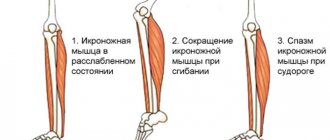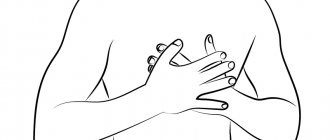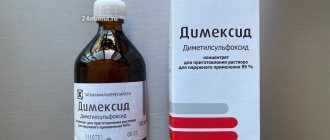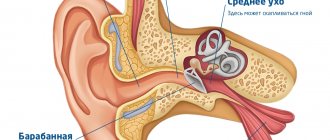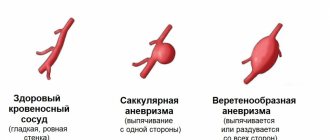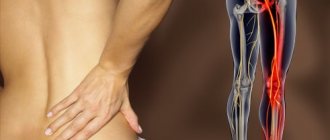If a lymph node in the groin is inflamed, it is always unpleasant, painful and dangerous to health. Read more in the article.
Lymphadenitis is an inflammatory process that affects the lymph nodes. Lymph nodes are organs that contain cells responsible for protecting the body.
Read an article on our website about where the lymph nodes are located on the human body . You will learn which lymph nodes become inflamed in various diseases.
These cells are interconnected with the body's circulatory system. They often become inflamed. Why is this happening and what to do? Find the answer to this and other questions in this article below.
Types of lymphadenitis - inflammation of the lymph nodes in the groin: photo
Types of lymphadenitis - inflammation of the lymph nodes in the groin
Lymph nodes react sharply to various infections and viruses that have arisen in the body; they are like filters in which all harmful, pathogenic bacteria are debugged. When there is inflammation, the lymph nodes in the groin or other parts of the body increase in size. This is clearly visible in the photo above. In medicine, there are two types of lymphadenitis:
- Specific
- Non-specific
Any doctor knows about each of them. More details:
- Nonspecific lymphadenitis is a mild form that occurs with common infections.
- Specific - caused by serious diseases: oncology, plague, tuberculosis.
Also, inflammation of the lymph nodes manifests itself in acute and chronic forms. The chronic form is a systematic increase in nodes, subsequently compaction and the appearance of adhesions. It is caused by the constant presence of infections in the pelvic area, and in some cases, simply not fully treated previous inflammation. The acute form is accompanied by sharp severe pain, high fever and poor health.
Where are the lymph nodes in the groin of women and men?
Lymph nodes in the groin
The inguinal lymph nodes in men and women are located on both sides of the lower pelvis, at the junction of the legs - on the outer and inner thighs. There are three types of inguinal nodes, depending on their location:
- The lower level is on the legs and down to the knee, they are called “groin tracks”.
- The middle level is in the area of the anus and genital opening.
- The upper level is on the buttocks, thighs.
Lymph nodes are also divided into superficial and internal:
- Superficial - easily palpable, visible in people with no fat deposits in the groin area.
- Deep - located in the place of the femoral vein, on the connective tissue of the abdominal wall.
When the lower level lymph nodes are inflamed, the cause is hidden in diseases and infections of the legs. With inflammation at the middle level, problems concern the anus and inguinal openings, genitals, at the upper level – the abdominal wall, buttocks.
Causes of enlarged inguinal lymph nodes
Infections of the genitourinary system
Lymphadenopathy in infectious diseases is caused by increased stimulation of the inguinal nodes and increased differentiation of lymphocytes. Enlarged lymph nodes are determined at the onset of the disease as a reactive reaction. Sometimes patients themselves identify “bumps” or nodes in the groin that are painful on palpation. Lymphoid formations have an elastic consistency, are not welded together and are not attached to the skin. Redness of the skin and an increase in local temperature are detected above the lymph nodes. Most often, lymphadenopathy is caused by:
- Genital herpes
. An increase in inguinal lymphatic formations occurs against the background of an increase in temperature and general malaise. With significant hyperplasia of the lymph node tissue, patients independently palpate the lumps located in the superolateral parts of the pubic area. Then multiple small bubbles with transparent contents appear on the skin of the perineum, bursting with the formation of erosions. - Primary syphilis
. With this disease, there is a unilateral increase in lymphoid formation, which can reach the size of a walnut. The node is painless on palpation, sometimes a dense cord is found coming from the lymph node, which is an inflamed lymphatic vessel. A couple of weeks before lymphadenopathy, a red, fleshy erosion appears on the skin of the genital organs - a chancre. - Chlamydia
. Bilateral inguinal lymphadenopathy due to chlamydia infection is more often diagnosed in men, since their infection often occurs in an acute form. Enlarged lymph nodes are sensitive to palpation; the skin over them, as a rule, is not changed. The symptom is accompanied by pain in the lower abdomen and mucopurulent discharge from the urethra. In women, there may be a slight enlargement of the lymph nodes without other manifestations. - Gonorrhea
. Increased antigenic stimulation causes increased differentiation of lymphocytes and an increase in the volume of lymphoid formations in the groin. The damage to the lymph nodes is often bilateral, the formations are sensitive when palpated, and slight hyperemia of the skin is detected above them. With gonorrhea in men, lymphadenopathy is combined with dysuric disorders, purulent urethral discharge in the morning. - Ureaplasmosis and mycoplasmosis.
Moderate enlargement of lymph nodes without signs of local inflammation is possible in both men and women, but an acute course with pronounced clinical symptoms is more typical for males. Against the background of inguinal lymphadenopathy, pain and pain are felt when urinating, and mucopurulent discharge from the urethra is noted. With intense inflammation, the skin over the lymph nodes becomes noticeably red.
Diseases of the female reproductive system
The high frequency of inflammatory processes in women is due to the anatomical features of the genital organs, the proximity of the entrance to the vagina and urethra, which contributes to the spread of pathogenic microorganisms. Exacerbation of inflammation is provoked by hypothermia, stress, and lack of personal hygiene. Enlargement of the inguinal lymph nodes occurs as a reaction of the lymphoid tissue to the inflammatory process, resulting in increased production of mature T- and B-lymphocytes in the antigen-dependent zones of the follicles. Inguinal lymphadenopathy in women is caused by:
- Vulvitis
. The acute version of inflammation is manifested by enlarged lymph nodes, itching and burning in the perineum, and moderate pain when urinating. Lymphadenopathy develops several days before the other symptoms of vulvitis; lymphoid formations are painless, so many women do not notice this symptom in time. Then the outer labia become red and swollen, and viscous mucus or pus is released from the vagina. - Bartholin gland abscess
. With massive purulent inflammation, a significant increase in the inguinal lymph node on the affected side is observed. During self-examination, a woman may palpate a large, painful “bump.” A typical sign of the disease is the appearance of a formation several centimeters in diameter in the labia area, which, when touched, causes sharp pain in the perineum. - Colpitis
. Enlarged lymph nodes with inflammation of the vagina are combined with low-grade body temperature and discomfort in the perineum. Inguinal lymphadenopathy during colpitis is characterized by bilateral lesions, small size of formations and mild pain upon palpation. Women note dysuria, moderate pain in the lower abdomen with irradiation to the groin, then vaginal discharge occurs.
Diseases of the male genital organs
Inflammatory processes of the reproductive system occur in men of different ages and are of great importance, since without treatment they cause severe complications and disrupt the quality of intimate life. Inguinal lymphadenopathy is a typical symptom of andrological pathology; regional lymph nodes enlarge due to antigenic stimulation of the paracortical and follicular zones. Hyperplasia of the inguinal nodes occurs in diseases such as:
- Balanitis
. With inflammation of the head of the penis, enlargement and tenderness of the inguinal lymph nodes are usually detected on both sides, and sometimes unilateral lymphadenopathy develops. A day or two after the onset of the symptom, the man begins to feel pain and burning in the area of the head and outlet of the urethra. When the inflammatory process spreads to the foreskin, balanoposthitis develops. - Orchitis
. With inflammation of the testicles, inguinal lymphadenopathy is one-sided, manifests itself 2-3 days before the main symptoms, lymphatic formations reach a size of 1.5-2 cm. Enlarged lymph nodes are accompanied by general malaise, myalgia, and increased body temperature. The man pays attention to the swelling and hyperemia of the scrotum, which are more pronounced on one side. There are sharp pains that intensify when walking. - Gangrene of the penis
. Destructive inflammation proceeds relatively slowly, so sometimes the lymph nodes manage to reach the size of a walnut. When palpated, the lymphoid formations are compacted, not fused with the skin and tissue, and moderately painful. Against the background of enlargement of the inguinal lymph nodes, specific changes in the penis are revealed - its skin dries out, turns black, and the process gradually affects the entire organ.
There may be explicit images of genitals hidden here.
Are you over 18 years of age?
Yes
No
Enlarged inguinal lymph nodes in a man
Oncological pathology
Typically, metastatic lesions of the inguinal lymph nodes are associated with malignant tumors of the reproductive system, which is due to the characteristics of lymph drainage. Lymphatic formations are slightly painful, immobile, and have a woody density. Patients complain of discomfort when wearing tight underwear and jeans. More often, patients discover lymphadenopathy on their own. Metastasis to the inguinal lymph nodes is also specific for anal cancer and skin neoplasia localized in the perineal area. Inguinal lymphadenopathy occurs with:
- Neoplasms of the female genital area
. Inguinal lymph nodes are the most common site of primary metastasis of malignant cells, since lymph from the pelvic organs passes through them. Lymphadenopathy, accompanied by frequent vaginal bleeding and pain in the lower abdomen, is typical of uterine carcinoma and fallopian tube cancer. Enlargement and hardening of the lymph nodes are found in vulvar melanoma and vaginal sarcoma. - Testicular cancer
. This tumor is characterized by early metastasis with damage to the inguinal lymphoid formations. More often, unilateral lymphadenopathy is observed, which corresponds to the affected testicle; with advanced neoplasia, the process becomes bilateral. The formations are dense and immobile. In the early stages, men notice asymmetry and swelling of the scrotum, then a dense, tuberous neoplasm appears. - Penile cancer
. Enlargement of the inguinal lymph nodes is pathognomonic for the edematous form of neoplasia. Lymphoid tissue is affected on both sides; the formations are very dense to the touch and do not move during palpation. The primary tumor is most often localized on the head of the penis: patients first notice a wart, a long-term non-healing ulcer or erosion with sanguineous or purulent discharge. When the form is advanced, phimosis occurs. - Germ cell tumors.
Neoplasms develop from germ cells of the reproductive system and can affect both men and women. Inguinal lymph nodes enlarge and become denser as the disease progresses; general lymphadenopathy indicates massive lymphogenous spread of tumor cells. Patients report urinary disorders, and in women the menstrual cycle is disrupted.
Hemoblastoses
Enlargement of the axillary, cervical, and inguinal lymph nodes is detected in myeloproliferative processes - leukemia, chronic lymphocytic leukemia. Lymphoid formations are dense, mobile, up to several centimeters in size. Generalized lymphadenopathy is accompanied by sweating and spontaneous bleeding. When immunity decreases, infectious diseases manifest. Enlarged lymph nodes are characteristic of T-cell lymphomas: Sezary syndrome, mycosis fungoides. The symptom is also observed in autoimmune lymphoproliferative syndrome.
Parasitic infestations
The increase in lymphoid formations is caused by an increase in local immune reactions in response to the penetration of the pathogen. Isolated damage to the inguinal nodes is possible with local parasitic infections of the perineal area; generalized lymphadenopathy is characteristic of protozoal diseases. Most often, a reaction from the lymphatic system is observed in pathologies such as:
- Helminthic infestations
. When a person is infected with tropical biohelminths, a group of helminthiasis similar in clinical picture may occur: filariasis, wuchereriosis, brugiosity. The reaction of the inguinal lymph nodes is caused by the direct pathogenic effect of pathogens. Lymphoid formations can increase in diameter up to 10 cm, the outflow of lymph from the lower extremities is disrupted, pronounced swelling of the scrotum in men and elephantiasis are noted. - Toxoplasmosis.
For the acquired form of infection, generalized lymphadenopathy with predominant damage to the inguinal and axillary lymph nodes is pathognomonic. The formations are moderately dense, mobile, painful when touched. The symptom is accompanied by the appearance of spotty or nodular rashes on the skin of the body, enlargement of the liver and spleen. In chronic toxoplasmosis, the mesenteric lymph nodes are involved. - Pediculosis
. Damage to the inguinal lymphoid structures is observed in the pubic form of the disease. The enlargement of the lymph nodes is bilateral, the formations have an elastic consistency, sizes up to 2 cm. Patients feel intense itching, especially at night, small bluish spots and scratches are found on the pubic skin. The common form of pediculosis pubis must be differentiated from adult pruritus.
Why are the lymph nodes in a woman’s groin inflamed - right, left: reasons
Lymph nodes in a woman's groin
Inflammation of the lymph nodes in the groin in women can occur on the left, right, or on both sides at the same time. An increase in nodes up to 1 cm is considered normal.
It is important to remember: Diseases also appear in these places: inguinal hernia, varicose veins during pregnancy, blockage and enlargement of the sebaceous glands. The signs of the diseases are similar, so it is important not to confuse them and make the correct diagnosis. Therefore, when the first signs of malaise and enlarged lymph nodes appear, consult a doctor.
The reasons for the increase may vary. Caused by non-dangerous diseases such as:
- Minor gynecological problems
- Acute respiratory infections and flu
- Appendicitis
- Inflammation of the genitourinary system
There are also dangerous causes of inflammation:
- Malignant tumors
- Melanoma
- lupus erythematosus
When lymph nodes enlarge to enormous sizes, allergic reactions occur. With minor diseases, the lymph nodes grow to a small size, and after treatment, they return to their original size. If they are inflamed for a long time and treatment does not produce results, it is worth examining for the presence of more serious diseases.
Survey
A diagnostic search for enlarged inguinal lymph nodes is aimed at identifying other signs of pathology and establishing the root cause of lymphadenopathy. The examination can be carried out by different specialists, depending on the leading clinical syndrome. An isolated change in the lymph nodes is a reason to contact a hematologist. The most valuable in diagnostic terms are the following instrumental and laboratory methods:
- Ultrasonography
. Ultrasound of lymph nodes is prescribed to determine the size of lymphoid formations and visualize their morphological structure. Sonography helps differentiate lymphadenopathy from cysts, hidradenitis and benign tumors. To clarify the diagnosis, ultrasound of the pelvic organs is often used. - Study of biopsy
. A biopsy of an enlarged lymph node is performed to study its cytological composition. A large number of lymphocytes indicates reactive inflammation of the lymphoid tissue. The presence of atypical cells indicates metastases of malignant tumors or cancer of the blood system. - Blood test
. A general blood test for inguinal lymphadenopathy is necessary to quickly detect signs of an inflammatory process. Severe pancytopenia or a significant change in the ratio of individual cell populations is typical for developing hemoblastosis. Additionally, biochemical analysis is carried out. - Serological reactions
. Lymphoid hyperplasia can be caused by various infectious diseases of the genitourinary tract. Therefore, to exclude them, ELISA and RSK are performed, which determine specific antibodies against the most common pathogens. In some cases, PCR diagnostics are performed to confirm the diagnosis.
Ultrasound examination of inguinal lymph nodes
Inguinal lymph nodes are inflamed, pain and fever - purulent lymphadenitis: causes
The inguinal lymph nodes are inflamed, the temperature also hurts - purulent lymphadenitis
. Purulent inguinal lymphadenitis most often occurs as a signal of the presence of sexually transmitted diseases or diseases of the pelvic organs. These are the main causes of this disease. First, the lymph nodes in the groin become inflamed and begin to hurt. Then the temperature rises.
If a patient exhibits the following symptoms, this indicates the need for immediate treatment:
- Increased body temperature (more than 38 degrees)
- The lymph node is enlarged, red and swollen
- Rapid heartbeat
- Labored breathing
Lymphadenitis turns into a purulent form, usually with repeated inflammation and perhaps not complete recovery after previous treatment. Purulent masses accumulate in the nodes, and then threaten blood poisoning. Possible complications are the development of sepsis and death.
Diagnostics
Having figured out why the lymph nodes in the groin become inflamed, you should know which doctor to contact and what examinations are necessary to make a diagnosis.
Women should be examined by a gynecologist. It is necessary to do a smear and bacterial culture to determine the composition of the vaginal microflora. Additionally, a PCR test may be prescribed. An ultrasound of the pelvic organs with examination of inflamed lymph nodes is required.
Men need to visit a urologist. After a general examination and medical history, the doctor will prescribe rectal palpation of the prostate gland. To exclude pathologies of the testicles, it is necessary to perform an ultrasound; in addition, a transrectal ultrasound of the prostate gland may be prescribed. A smear from the urethra and a bacterial culture of prostate juice are required if there is a suspicion of prostatitis.
Both women and men are prescribed general and biochemical blood tests.
The lymph nodes in the man’s right and left groin became inflamed: why?
Lymph nodes in the right and left groin
To determine the cause of inflammation of the lymph nodes in the right and left groin, a man urgently needs to undergo a full examination:
- X-ray
- Ultrasound
- Blood and urine analysis
Consolidation and the appearance of pain in the inguinal lymph nodes is a serious symptom. The reasons may be the following:
- Sexually transmitted diseases
- Oncological neoplasms
- Prostatitis
- Tuberculosis
- Kidney failure
- HIV infection
If the following symptoms appear, you should consult a doctor:
- Enlarged lymph nodes
- The appearance of edema
- Soreness
- Temperature increase
- Feeling worse
- Redness at the location of the lymph node
The nodes can become inflamed due to hypothermia and injuries to the genital organs.
Symptomatic therapy
Inguinal lymphadenopathy usually does not require specific treatment; unpleasant symptoms disappear some time after treatment of the underlying disease that caused the enlargement of the lymph nodes. Analgesics and anti-inflammatory drugs are used to relieve pain. For hematological malignancies and other oncological pathologies, longer and more serious therapy is required. If you detect dense formations in the inguinal folds, you should immediately consult a specialist, since early diagnosis significantly increases the likelihood of a complete recovery.
A child, a boy, has an inflamed lymph node in the groin - on the right, on the left: reasons, what to do?
A child, a boy, has an inflamed lymph node in the groin.
If the lymph nodes in a child are inflamed, it is necessary to urgently conduct an examination and carefully monitor his condition. Most often, in children, the disease is mild, manifested only by an increase in the size of the lymph nodes. Pain and fever are less common. Boys may develop an inguinal hernia, which causes inflammation of the lymph node in the groin on the right or left. Here are more reasons:
- The causative agents of inflammation are the presence of infections or pathogenic microorganisms.
- The child's body reacts sharply to all changes.
- In some cases, enlargement is caused by malignant neoplasms, but this is quite rare.
- Frequent causative agents of lymphadenitis are streptococci and staphylococci.
- If there are wounds or rashes in the pelvic area, pathogenic microorganisms can enter the body, and later, when they enter the lymph, end up in the lymph node.
In this case, the main thing is to determine the cause of the inflammation and direct all efforts to treat it. Subsequently, the inflammation will stop. There are several points and actions prohibited for lymphadenitis:
- Heat the site of inflammation - as the temperature rises, bacteria develop faster.
- Smear the lymph nodes with solutions containing alcohol.
- Palpate the site of inflammation many times - this can speed up the entry of harmful microbes into the body.
If there is a hereditary predisposition to problems with lymph nodes, parents can rest assured that children’s immunity copes with these problems faster and easier than adults.
Structure of the groin area
The groin area includes:
- Pelvis – it contains the internal organs of the genitourinary system. The pelvis consists of two pelvic bones, the coccyx and the sacrum. During childbirth, the pelvis plays the role of a channel that carries the fetus out.
- The bladder is part of the genitourinary system; its main function is to store urine and remove it through the urethra.
- The urethra is an organ that is a tube. In women, the tube has a length of three to five centimeters and performs the only function of removing urine from the body. The short length and width of the urethra facilitate the entry of pathogenic microorganisms into the body that cause inflammation.
- The rectum is the last organ of the digestive tract. The main functions of the rectum are the formation and accumulation of feces.
- The ovaries are paired glands of the female reproductive system; follicles develop in them, an egg is formed, and hormones are produced. A dominant follicle is formed in the ovary every month, and an egg develops inside it. When the follicle bursts, an egg is released: the process of ovulation occurs. Subsequently, the egg passes through the fallopian tube into the uterine cavity. If conception does not occur, the woman begins her period.
- The fallopian tubes are a paired organ consisting of tubes, the main function of which is to release the egg into the uterine cavity.
- The uterus is a muscular organ of the female body. The uterus is the receptacle for the fetus and brings it out during childbirth. One of the functions is menstrual, provoking the excretion of the mucous membrane of this organ.
- The vagina is a muscular fibrous tube reaching a length of six to ten centimeters. The vagina performs a protective function, keeping the reproductive organs safe. Vaginal discharge is considered normal, as it is necessary to moisturize the mucous membrane and prevent drying. Healthy discharge is white, transparent, mucous and does not have a bad odor.
In addition to the above organs in the groin area, the uterine ligaments, nerves and lymph nodes are susceptible to inflammation.
A teenager has an inflamed lymph node in the groin and swelling on the right and left sides: causes
A teenager has an inflamed lymph node in the groin and is swollen.
The maximum number of lymph nodes is formed in children after ten years. It is known that an adult has more than four hundred of them. It often happens that in adolescents, the lymph nodes in the groin become inflamed and swell - on the right or left side. The reasons for this condition may be the following:
- Infectious diseases
- Oncological diseases
- Changes in hormonal levels
Enlarged lymph nodes also indicate infections in the lower extremities, skin or muscles. You should also inspect the patient’s lower body for the presence of rashes, boils, wounds, and ulcers. Also, this may indicate the following ailments:
- Diseases of the genital organs, inflammation of the joints.
- In rare cases, there are consequences of the vaccine, but enlarged lymph nodes are considered normal, even for one month.
- With frequent blows, wounds and scratching on the legs, adolescents may experience a constant enlargement of the lymph nodes.
There are cases when a patient initially has enlarged lymph nodes in one part of the body, and later in all others. This occurs when the disease:
- measles
- Hepatitis
- Pneumonia
- Eczema
- Syphilis
- Toxoplasmosis
Only a doctor can make the correct diagnosis.
Inflamed lymph node in the groin area during pregnancy: reasons, what to do?
Inflamed lymph node in the groin area during pregnancy
Pregnancy is a time when many changes occur in a woman’s body. It is important to monitor the body's reactions. It is known that immunity is an excellent protector of our body. To prevent it from harming the unborn child, all systems operate in a gentle manner. But there is another side to this property: a pregnant woman is more exposed to various diseases and infections. Therefore, the likelihood of lymphadenitis during pregnancy is very high.
Lymphadenitis during an interesting position of a woman is usually not inflammatory or infectious. Causes of inflammation of the lymph nodes in the groin area during pregnancy:
- Pain in the areas of the lymph nodes can be a common reaction to changes in hormonal levels, to proteins that are produced by the placenta and fetus.
- The formation and change of the mammary glands can also cause enlargement of the lymph nodes.
- Often, during pregnancy, allergic reactions to fabrics, household items, chemicals, and cosmetics develop. Unpleasant symptoms usually stop bothering you a few days after the baby is born.
If inflammation, swelling, or redness does appear, then it is necessary to undergo a comprehensive examination to exclude possible serious diseases.
Possible complications
Inguinal lymphadenectomy is an unpleasant operation and is accompanied by the risk of developing some complications:
- Lymphorrhea and seromas are accumulations of lymph in the wound. On average, this lasts about 2 weeks, but can last up to 1 month. The accumulation of lymph in the wound is a risk factor for secondary infection and skin necrosis. If the seroma is extensive, it can cause rapid growth of connective tissue and the formation of keloid scars.
- Swelling of the vulva or scrotum.
- Swelling of the legs, up to the development of lymphedema (elephantiasis of the limb). Edema can be local, when, for example, only the foot or hand is affected, or extensive, when the entire limb and tissues of the lower half of the body are involved in the process. Swelling is accompanied by pain and loss of muscle strength.
As part of the treatment of lymphedema, complex therapy is carried out, including compression, drainage massage, a complex of physical therapy and skin care of the affected limb.
In order to prevent or minimize the risks of developing this pathology, it is necessary to strictly adhere to a number of rules:
- Avoid the formation of edema, even minor, on the affected limb. When they form, it is necessary to wear compression stockings.
- You should avoid any manipulations that could lead to a local increase in pressure on the affected limb - standing for a long time, wearing uncomfortable shoes, including dress shoes with heels.
- Carefully ensure that the skin on the feet is not damaged, avoid the formation of calluses, injuries, and maceration. Do not walk barefoot even on the floor at home, etc.
- Sharp temperature fluctuations should be avoided - baths, saunas, swimming pools, etc.
Inflamed lymph nodes in the neck and groin: causes of cervical and inguinal lymphadenitis at the same time
The lymph nodes in the neck and groin are inflamed.
The largest concentration of lymph nodes is located on the human neck. There are many factors that cause cervical lymphadenitis to develop. Here are the probable causes of inflammation of the lymph nodes in this area:
- Diseases of the nasopharynx or oral cavity (caries, sinusitis, stomatitis)
- Chickenpox, smallpox, cytomegalovirus, measles
- Otitis
- Skin rashes, boils
- Colds, flu and ARVI
If inflammation appears in the neck or groin, consult a doctor immediately. After the examination, the doctor will determine the main cause of this problem. After undergoing the necessary treatment, the lymph nodes will shrink to their original size on their own. Of particular concern:
- Enlarged lymph nodes in the absence of any symptoms.
- In this case, you need to go to the hospital immediately to exclude the presence of serious diseases.
- This may be the cause of HIV infection, cancer changes, and autoimmune diseases.
Very important point : The cervical lymph nodes are very close to the brain, so if suppuration occurs, the risk of infection of the brain will be very high. It is important to help the body in time to fight the cause of inflammation.
To speed up diagnosis, cervical nodes are divided into the following types:
- Retropharyngeal
- Submandibular
- Submandibular
- Chin
- Anterior and posterior cervical
- Anterior, posterior
In some cases, the increase occurs from:
- Hypothermia
- Decreased immunity
- Increased stressful situations
- Vitamin deficiency
- Anemia
- Allergies
- Problems with the thyroid gland
- In case of damage and impacts to places where lymph nodes accumulate
If the lymph nodes in the neck and groin become inflamed at the same time, this may indicate the presence of a serious pathology in the body associated with hormonal levels, hematopoiesis and other important systems. At this point, it is important to consult a doctor in a timely manner.
The lymph node between the leg and groin is inflamed: causes
The lymph node between the leg and groin is inflamed.
Inguinal lymphadenitis is often caused by significant reasons, since during illness, the human immune and lymphatic systems are activated. If the infection is severe, inflammation occurs on both sides. If the lymph node between the leg and groin is inflamed, then here are the reasons for this illness:
- Sexually transmitted sexually transmitted diseases (syphilis, gonorrhea, chlamydia).
- Gynecological diseases (adnexitis, endometritis, bartholinitis and tumors). If these diseases are usually asymptomatic, inflammation of the lymph nodes will be an alarm bell for the necessary examination.
- Urological diseases: inflammation of the urinary ducts and bladder.
- Skin rashes.
- Common injuries, cuts, bruises of the lower extremities, buttocks.
- Tick bites on the lower limbs (borreliosis).
- Fungal infections.
- Viral infections.
If the infection penetrates from the outside, then inflammation occurs in one place, or on one side. This happens when a tick bites. The lymph node may become inflamed on one side, usually near the leg where the bite occurred.
The lymph node in the groin is inflamed and swollen - what to do, how to treat it: antibiotics, other drugs
The lymph node in the groin is inflamed and swollen - what to do, how to treat it: antibiotics
When the lymph node in the groin swells and hurts, it is always unpleasant. How to treat? What to do in this case? There are two types of treatment for inflammation of the lymph nodes in the groin:
- Radical
- Conservative
Radical treatment requires surgery. This is the last measure if there is an advanced stage of the disease, suppuration, risk of infection and sepsis. In this case, local anesthesia is used, the node is opened, the pus is removed and antibiotics are placed in the wound.
If lymphadenitis is in a mild stage, the disease can be treated conservatively:
- Antibiotics
- Ointments for inflammation and other drugs
- Painkillers
- Electrophoresis
- Ultrasonic exposure
Additionally, immunostimulants and antiviral drugs are prescribed. Proper nutrition and light exercises are recommended.
Remember: As for drugs, antibiotics are used with a wide spectrum of action, most often of the penicillin series; the dosage and period of use are calculated by the doctor.
Antiseptic ointments - compresses are applied from them.
Attention: Compresses are strictly prohibited in the presence of a purulent stage of inflammation.
Treatment
Conservative therapy
The therapeutic plan is drawn up taking into account the cause of groin pain. Women can be prescribed:
- Painkillers.
To eliminate pain, analgesics and NSAIDs are used. Medicines may be used strictly as prescribed by a specialist after diagnosis. Failure to follow recommendations can smooth out the symptoms of pathology and make it difficult to identify dangerous conditions. - Antibacterial agents.
For nonspecific infectious processes, broad-spectrum drugs are used; after receiving the culture results, the antibiotic is replaced, taking into account the sensitivity of the microorganisms. For specific infections, drugs are selected that have the most powerful effect on a particular pathogen. - Other medicines.
Depending on the nature of the pathology, treatment can be carried out using diuretics, antispasmodics, etc. In some cases, women are prescribed hormonal therapy. For pain in the groin caused by orthopedic diseases, therapeutic blockades are performed. - Physiotherapy.
UHF, electrophoresis, ultrasound, laser therapy, and magnetic therapy can be effective. When joints and ligaments are affected, the regimen includes massage and physical therapy.
Radiation therapy or chemotherapy is indicated for patients with cancer pathologies. For local purulent processes, dressings are performed.
Surgery
Women with pain in the groin area undergo the following operations:
- Local infections, lymphadenitis:
opening, drainage of boils, abscesses; opening of purulent lymphadenitis and adenophlegmon. - Hernias:
laparotomic and laparoscopic hernioplasty for inguinal and femoral hernias using own tissue or mesh grafts. - Gynecological pathologies:
opening of an abscess and removal of the Bartholin gland, excision of foci of endometriosis, laparoscopic tubotomy or tubectomy for ectopic pregnancy, removal of cysts, fibroids and benign tumors, amputation of the uterus, hysterectomy or panhysterectomy for malignant neoplasia. - Urological diseases:
various options for lithotripsy for stones, ureterolithotomy, pyelolithotomy, ureteral stenting, partial and radical nephrectomy, TUR of the bladder, cystectomy. - Gastrointestinal diseases:
open or laparoscopic appendectomy, elimination of intestinal obstruction, dissection of adhesions or bowel resection for intestinal obstruction. - Orthopedic pathologies and injuries:
operations for ARS syndrome, endoprosthetics, open osteosynthesis of the femoral neck.
A severely inflamed lymph node in the groin of women and men: treatment with folk methods
Treatment of inflammation of the lymph node with folk methods: peppermint
Lymphadenitis is a dangerous disease, therefore, before starting treatment with folk methods, you must consult with your doctor. After examination and confirmation of the absence of dangerous pathologies, you can begin alternative types of treatment using traditional methods. If the lymph node in the groin is severely inflamed in women and men, then you can use the following traditional methods:
- Peppermint - make cuts on the leaves of the plant and apply to the site of inflammation.
- Compress with dandelion flowers - take the inflorescences, squeeze out the juice, pour on gauze for a compress and apply to the sore spot for a couple of hours. Do the procedure in the morning and evening.
- Celandine juice - use washed flowers of the plant. Grind and add alcohol to the released juice in a 1:1 ratio. Dip the gauze into boiling water, then into the mixture, then apply it to the site of inflammation, insulate it and leave it overnight.
- Fir balsam - buy it at the pharmacy. Pour one teaspoon into a glass of water and drink half an hour before meals. There is also an ointment with fir, which also effectively acts on inflammation.
- Echinacea tincture has anti-inflammatory properties. Take 25 drops of tincture per glass of water and stir. Drink twice a day, before meals. Treatment lasts 12 days .
Be sure to consult your doctor about the dosage of herbs and tinctures you take. After all, traditional methods are also medicines and everything is individual.
Prevention of lymphadenitis
Prevention of lymphadenitis
The main way to prevent inguinal lymphadenitis is:
- Healthy lifestyle
- Proper nutrition
- Sports activities
- Getting rid of bad habits
You should also use protection during sexual intercourse and avoid casual intimate contact. Take care of your personal intimate hygiene. Replenish your body with vitamins and nutrients in a timely manner.
If inflammation does occur, carry out full treatment to exclude recurrent lymphadenitis and the development of a chronic form. It is important to avoid injury and hypothermia.
The lymph node in the groin is inflamed - what treatment of lymphadenitis helps: reviews
The lymph node in the groin is inflamed.
The most effective way to treat lymphadenitis is to take antibiotics. But there are many effective methods of treatment at home, of course, after the doctor’s permission. Read reviews of other people who were treated for inflammation of the lymph nodes in the groin. They describe what treatment for lymphadenitis helped them.
Vera, 45 years old
Recently I had lymphadenitis in the groin. There was obvious swelling. In addition to the main treatment, herbal tinctures of yarrow and St. John's wort helped. I took it internally. This treatment helped get rid of the cause of inflammation - infections, bacteria. At the same time, the herbs increased immunity. Eating more vitamin C, onions, garlic, and cranberry juice also helped in treatment.
Sergey, 51 years old
One of the most effective ways to remove inflammation of the lymph nodes is a herbal mixture, which includes: currant leaves, elderberry, calendula, lavender and wormwood leaves. My wife prepared it for me this way: she took one part of each plant, poured boiling water over it and left it to steep for 12 hours. The next day I filtered it and I drank it within 24 hours. The course of treatment is one month. The tincture completely cleanses the body of pathogenic bacteria and improves immunity.
Sofia, 32 years old
Inflammation of the lymph node in my groin began after hypothermia. One method helped, which has proven itself in treatment for many people. Compress based on walnut leaves. You can use a pharmacy tincture by mixing 50 grams of this mixture and 100 grams of alcohol. You need to insist for two days. You can brew walnut partitions as tea and drink throughout the day (1 tsp per glass of boiling water).




